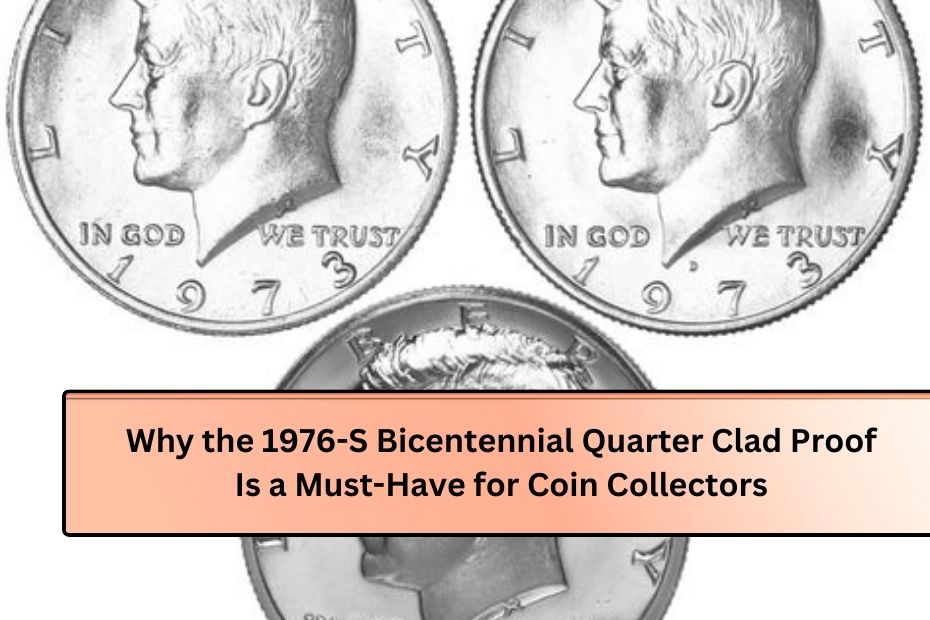The 1976-S Bicentennial Quarter Clad Proof is a special coin made to celebrate America’s 200th birthday. The U.S. Mint produced this coin along with others in 1975 and 1976 to mark this important occasion. In addition to the 1976-S, there are other versions of the Bicentennial Quarter, including those minted in Philadelphia and Denver. These quarters feature a unique design, known as the “Drummer Boy,” created by graphic designer Jack L. Ahr.
| Feature | Details |
|---|---|
| Year Minted | 1976 |
| Mint Location | San Francisco (S) |
| Design | Drummer Boy by Jack Ahr |
| Commemorative Purpose | 200th Anniversary of the United States |
| Total Minted | 4,149,730 Proof Sets (in 1976) |
| Face Value | $0.25 |
| Original Issue Price | $7.00 (equivalent to $38.42 in 2024) |
| Popularity | Highly sought after by collectors |
| Current Population (PR70DCAM) | 872 as of October 2024 |
| Noteworthy Auction Prices | Sold for $920 in 2010 |
| Design Features | Features a drummer in a tricorn hat |
| Minting Composition | Clad Proof (copper-nickel) |
The History of Bicentennial Coins
The Proposal for Commemorative Coins
In the early 1970s, as the nation prepared to celebrate its Bicentennial, the American Revolution Bicentennial Commission suggested creating special coins. At first, the idea was rejected because the Treasury Department worried about too many commemorative coins leading to unsold items. They were concerned that people might hoard these special coins, which could result in a shortage of regular circulating coins.
Changes in Public Opinion and Lobbying
However, the numismatic community, which is made up of coin collectors and enthusiasts, strongly pushed for the creation of these commemorative coins. In 1972, the Treasury agreed to include the date 1776 on the coins but didn’t change their designs at that time. After much lobbying, Congress eventually authorized new designs for the quarter, half dollar, and dollar coins.
Competition for Coin Designs
To decide on the designs for the Bicentennial coins, the Treasury Department held a design competition starting in 1973. Five judges reviewed submissions from across the country, and the winners each received $5,000. The winning designs were revealed to the public on March 7, 1974, during an appearance by Mint Director Mary Brooks on NBC’s Today show.
The Popular Design of the Bicentennial Quarter
Jack Ahr’s Drummer Boy
The most famous design from the Bicentennial series is Jack L. Ahr’s “Drummer Boy” design, which is featured on the Washington Quarter. This design shows a Revolutionary War drummer, making it the only Bicentennial coin that displays a human figure. The image of a drummer in a tricorn hat became widely recognized as towns celebrated the nation’s birthday with parades. Mint Director Brooks described the quarter as having “a most romantic history,” evoking images of pirates and treasure.
How the 1976-S Bicentennial Quarter Clad Proof Was Sold
Mint Sales and Popularity
The Bicentennial coins became very popular among collectors. The U.S. Mint reported selling nearly 3 million Proof Sets in 1975 and over 4 million in 1976. Each Proof Set included the three Bicentennial coins, with a combined face value of $1.91. The original price for these sets was $7.00 (equivalent to about $38.42 in today’s money).
Resuming Production of the Washington Quarter
In 1977, the Mint returned to producing the regular design of the Washington Quarter. Over one billion Bicentennial quarters circulated just like the 50 State Quarters and America the Beautiful Quarters we see today. While many of these coins remain in circulation, some Proof Sets have changed hands among collectors over the years.
Market Data and Noteworthy Sales
The Value of the 1976-S Bicentennial Quarter
The value of the 1976-S Bicentennial Quarter Clad Proof has been influenced by collectors and their interest in high-quality coins. For a short time, the coin was considered rare in perfect condition (graded PCGS PR70DCAM). This grade is hard to find, and the number of coins in this category has increased from 826 in April 2024 to 872 by October 2024.
Auction Prices and Trends
Notable sales of the 1976-S Bicentennial Quarter include examples connected to high-ranking collectors. For instance, a coin sold for $920 in 2010, which is still a record price. Prices for this coin had been declining until 2016 when it started to reach higher levels again.
Population Data for Graded Coins
As of October 2024, the population for the 1976-S Bicentennial Quarter in PR70DCAM continues to rise. Meanwhile, the population of coins graded by NGC remains low at just 12 pieces. Collectors are advised to consider the PCGS graded coins as the market evolves.
Conclusion: A Collectible with Historical Significance
The 1976-S Bicentennial Quarter Clad Proof is not just a piece of currency; it represents a significant moment in American history. Produced to celebrate the country’s 200th birthday, this coin holds value for collectors both for its design and its story. The popularity of these coins highlights the importance of commemorative coinage in celebrating national milestones.
Over time, the interest in the 1976-S Bicentennial Quarter has shown how collectibles can bridge the past and present, appealing to both seasoned collectors and new enthusiasts alike. With increasing awareness and the continued availability of Proof Sets, the 1976-S Bicentennial Quarter remains a valuable part of American numismatic history.
FAQs
1. What is the 1976-S Bicentennial Quarter Clad Proof?
The 1976-S Bicentennial Quarter Clad Proof is a commemorative coin issued by the U.S. Mint to celebrate the 200th anniversary of the United States. It features a design by Jack Ahr depicting a Revolutionary War drummer.
2. How many 1976-S Bicentennial Quarters were made?
The U.S. Mint produced 4,149,730 Proof Sets in 1976, which included the Bicentennial Quarter. This coin is also part of the 1975 and 1976 sets, which were popular among collectors.
3. What is the significance of the dual date 1776-1976?
The dual date represents the 200-year anniversary of the Declaration of Independence, marking a significant moment in American history.
4. What does “Clad Proof” mean?
“Clad Proof” refers to the coin’s minting process, where a layer of copper-nickel is applied over a core, creating a shiny, mirror-like finish. This type of coin is made specifically for collectors.
5. Why are these coins popular with collectors?
These coins are popular due to their historical significance, unique design, and limited mintage. They are often sought after for their beauty and as part of a larger collection.

